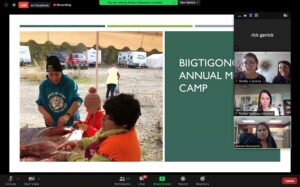Building Indigenous Food Sovereignty in 14 First Nations in Northern Superior region

By Rick Garrick
THUNDER BAY— Indigenous rural development economist Winona LaDuke spoke about heading to the sugar bush when the coronavirus disease 2019 (COVID-19) pandemic hit during the Building Indigenous Food Sovereignty virtual meeting on Sept. 16.
The Building Indigenous Food Sovereignty in and around Anishinawbewi Gitchi-Gami and Animbiigo Zaagiigam meeting was held via Zoom by the Thunder Bay District Health Unit and the Indigenous Food Circle, which works with 14 First Nations in the Thunder Bay area.
“It seemed like the best thing to do, get out of town, head for the woods,” LaDuke says. “So I’ve been doing this, just reintegrating myself into my lifestyle that the Creator gave us.”
LaDuke says her work at Winona’s Hemp and Heritage Farm, located at the White Earth Reservation in Minnesota, is about food sovereignty.
“What Anishinabe people know is that you go in the woods to get the food, go to the lake and get the food — the store is there, that’s where you’ve got to go,” LaDuke says. “We’ve got to be those people, like our ancestors who went out there and got that [food], because that’s what food sovereignty is about, and that’s a return to our original instructions.”
LaDuke says she began farming about 30 years ago and now grows Indigenous varieties of corn and other foods.
“In a time of climate change, what you want to be growing is these old seeds,” LaDuke says, noting that Indigenous people grew about 8,000 varieties of corn. “Some of those corn varieties went way into northern Manitoba, so what we know is some of these varieties are resilient and they can adapt.”
LaDuke says Indigenous people need to plant their gardens.
“We have all of the tools we need to take care of our future generations,” LaDuke says. “We just need to take care of those gifts the Creator gave us. I like to talk about when America was great — America was great when there were 8,000 varieties of corn, America was great when there were 50 million buffalo.”
LaDuke adds that she also grows Gete-okosomin (really cool, old) squash and other varieties of squash on her farm. Gete-okosomin squash, a brilliant orange squash which grows about three-feet long, was rediscovered by archeologists in 2008 in an 850-year-old clay ball full of seeds in Wisconsin.
“I had a good year of these [Gete-okosomin] squash this year but a better year of Lakota squash,” LaDuke says. “We may not have a lot of warmth but we have long days so these things will grow — these varieties were developed specifically for our territory by our ancestors.”
The Building Indigenous Food Sovereignty virtual meeting also included presentations by staff from Red Rock Indian Band on a community garden and construction of a moose hanger and butcher shop and Biigtigong Nishnaabeg on community food programs, a community garden and an annual moose camp.
“[The moose hanger] can hold four moose at one time — once that was complete we started moving on to the butcher shop,” says Joanne Decicco, employment counsellor at Red Rock Indian Band. “This is a way to get back to our traditional food.”
Lisa Michano-Courchene, director of education at Biigtigong Nishnaabeg, says children have been attending the annual moose camp since 2008.
“It is part of our curriculum, they do it yearly and it has grown over the years,” Desmoulin says, noting there have been up to 250 people at the camp. “That is their school for the week and they are engaged in hunting, harvesting and a number of activities around camp. A big part is obviously food, how to process the meat, how to do some of the drying of the meat, but it’s also relationship building and visiting with those Elders and valuing the food that comes from the land.”


